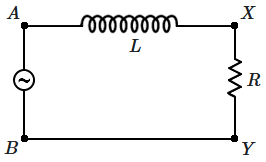In an AC circuit, an alternating voltage \(\varepsilon=200 \sqrt{2} \sin (100 t)~\text{V}\) is connected to a capacitor of capacity \(1~\mu \text{F}.\) The RMS value of the current in the circuit is:
| 1. | \(100~\text{mA}\) | 2. | \(200~\text{mA}\) |
| 3. | \(20~\text{mA}\) | 4. | \(10~\text{mA}\) |
Subtopic: RMS & Average Values | Different Types of AC Circuits |
76%
From NCERT
AIPMT - 2011
To view explanation, please take trial in the course.
NEET 2025 - Target Batch
Hints
Links
To view explanation, please take trial in the course.
NEET 2025 - Target Batch
A \(15.0~\mathrm{\mu F}\) capacitor is connected to a \(220~\mathrm{V}\), \(50~\mathrm{Hz}\) source. If the frequency is doubled, what happens to the capacitive reactance and the current?
| 1. | the capacitive reactance is halved and the current is doubled. |
| 2. | the capacitive reactance is doubled and the current is halved. |
| 3. | the capacitive reactance remains the same and the current is doubled. |
| 4. | the current remains the same and the capacitive reactance is halved. |
Subtopic: Different Types of AC Circuits |
78%
From NCERT
To view explanation, please take trial in the course.
NEET 2025 - Target Batch
Hints
Links
A resistor of \(200~\mathrm{\Omega}\) and a capacitor of \(15.0~\mu\text{F}\) are connected in series to a \(220~\text{V}\), \(50\) Hz AC source. The voltage (RMS) across the resistor and the capacitor are respectively:
1. \( 160.3 ~\text{V}, 160.3 ~\text{V} \)
2. \( 151 ~\text{V}, 151 ~\text{V} \)
3. \( 160.3 ~\text{V}, 151 ~\text{V} \)
4. \( 151 ~\text{V}, 160.3 ~\text{V}\)
Subtopic: Different Types of AC Circuits |
From NCERT
To view explanation, please take trial in the course.
NEET 2025 - Target Batch
Hints
Links
To view explanation, please take trial in the course.
NEET 2025 - Target Batch
An AC source is connected to the given circuit. The value of \(\phi\) will be:


| 1. | \(60^\circ\) | 2. | \(90^\circ\) |
| 3. | \(30^\circ\) | 4. | \(45^\circ\) |
Subtopic: Different Types of AC Circuits |
63%
From NCERT
NEET - 2023
Please attempt this question first.
Hints
Please attempt this question first.
If \(Z_1\) and \(Z_2\) are the impedances of the given circuits (a) and (b) as shown in figures, then choose the correct option:


| 1. | \(Z_1<Z_2\) | 2. | \(Z_1+Z_2=20~\Omega\) |
| 3. | \(Z_1=Z_2\) | 4. | \(Z_1>Z_2\) |
Subtopic: Different Types of AC Circuits |
61%
From NCERT
NEET - 2023
Please attempt this question first.
Hints
Please attempt this question first.
For very high frequencies, the effective impedance of the circuit (shown in the figure) will be:


| 1. | \(4~ \Omega\) | 2. | \(6~ \Omega\) |
| 3. | \(1~ \Omega\) | 4. | \(3~ \Omega\) |
Subtopic: Different Types of AC Circuits |
From NCERT
NEET - 2023
Please attempt this question first.
Hints
Please attempt this question first.
A series \(LCR\) circuit with inductance \(10~\mathrm{H}\), capacitance \(10~\mu F\), resistance \(50~\Omega\) is connected to an AC source of voltage, \(V=200 \sin (100 t) \text { volt }\). If the resonant frequency of the \(LCR\) circuit is \(\nu_0\) and the frequency of the AC source is \(\nu\), then:
| 1. | \(\nu=100 \mathrm{~Hz} ; ~\nu_0=\frac{100}{\pi} \mathrm{~Hz}\) |
| 2. | \(\nu_0=\nu=50 \mathrm{~Hz}\) |
| 3. | \(\nu_0=\nu=\frac{50}{\pi} \mathrm{Hz}\) |
| 4. | \(\nu_{0}=\frac{50}{\pi}~ \mathrm{Hz}, \nu=50 \mathrm{~Hz}\) |
Subtopic: Different Types of AC Circuits |
72%
From NCERT
NEET - 2022
To view explanation, please take trial in the course.
NEET 2025 - Target Batch
Hints
To view explanation, please take trial in the course.
NEET 2025 - Target Batch
A household ac circuit has an applied voltage of \(220\) V (RMS) and the current flowing through the circuit is \(2.2\) A (RMS), the phase difference between them being \(60^\circ.\) Then:
| 1. | the impedance in the circuit is \(100~\Omega.\) |
| 2. | the resistance in the circuit is \(200~\Omega.\) |
| 3. | the power dissipated is \(484\) W. |
| 4. | all the above are true. |
Subtopic: Different Types of AC Circuits |
54%
From NCERT
Please attempt this question first.
Hints
Please attempt this question first.
An alternating emf (ac) is applied across the circuit shown in the figure. Let \(V_{AX}\) be the voltage across the inductor \(L,\) and \(V_{XY}\) be the voltage across the resistor \(R.\) Let the angular frequency be \(\omega.\) The phase difference between \(V_{XY}\) and \(V_{AX}:\)


| 1. | depends on the ratio \(\frac{\omega L}{R}\) |
| 2. | depends on the quantity \(\sqrt{(\omega L)^2+R^2}\) |
| 3. | depends on \(L\) and \(R,\) but not on \(\omega\) |
| 4. | is independent of \(L,R,\omega\) |
Subtopic: Different Types of AC Circuits |
From NCERT
Please attempt this question first.
Hints
Please attempt this question first.
Two circuits: \((1)\) an \(L\text-R\) circuit and \((2)\) an \(R\text-C\) circuit are driven by the same alternating current. The phase difference between the current and the voltage is twice in the \(1\)st case with respect to the \(2\)nd case and both the angles add up to \(90^\circ.\) The resistances are equal in both cases. The ratio of their reactances (first: second) is:
1. \(\sqrt3:1\)
2. \(1:\sqrt3\)
3. \(3:1\)
4. \(2:1\)
1. \(\sqrt3:1\)
2. \(1:\sqrt3\)
3. \(3:1\)
4. \(2:1\)
Subtopic: Different Types of AC Circuits |
62%
From NCERT
Please attempt this question first.
Hints
Please attempt this question first.


